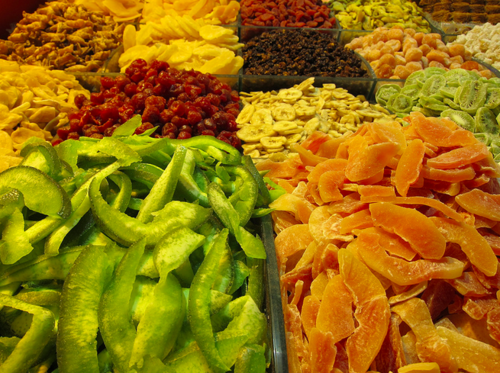
Drying food is a principal means of preserving some types of food long term. Typical food types that are dried for short- to long-term storage are fruit and vegetables. Dried meat is known as jerky. Many herbs and spices are dried (leaves, seeds, fruits).
Dried food has the benefit of lasting through winter and other lean periods and is a useful way to preserve large harvests that cannot be kept stored at room temperature, outside or by freezing/refrigeration.
Since dried food is often light, it is a useful food for carrying when travelling, hiking, backpacking, camping, etc. Dried fruit is a handy snack for many occasions.
Means for drying food[edit | edit source]
Food can be dried in various ways that ensure long-term preservation. These means include:
- Drying in the sun on racks, screens, cloth, bark, etc. (fruits only)
- Using an oven (electric, gas, microwave, solar, etc.) at a low temperature (note that microwave drying is usually reserved for herbs, as it tends to cook rather than dry food)
- Using a dehydrator (good for drying food but also for making fruit leathers; these are more cost efficient than ovens, especially if you dry a lot of food, often)
- Air drying (such as hanging the food in a well-ventilated place to allow it to dry in warm air)
Food safety when drying food[edit | edit source]
Clean food before drying to remove grime, blemished parts and anything likely to be too fibrous once dried. You may also need to remove stems, pits, seeds, skin, etc., depending on what the food is.
Food must be dried in the right conditions to ensure that mold and bacteria cannot grow and spoil the food or cause it to be unsafe to eat. Conditions must be suitably warm (a low and steady heat, not so high that it cooks the food), low in humidity and well ventilated to ensure even and complete drying of foods.
Sun drying is only appropriate for fruit and it should only be done when there is sufficient heat, e.g., long hot summer days with warm nights. If you live in a cool climate with high humidity and cool night temperatures, sun drying is not recommended. Even where the days are hot, it is advisable to bring the racks or screens with drying food indoors at night if the nights get cool or moist. The drying area should also be protected from insects (use netting, muslin, screens, etc.); expect that insects will be attracted to the flesh of fruits and vegetables while still fresh. If there is not sufficient air circulation, a fan may be needed to assist the drying.
Read the manufacturer's instructions for your dehydrator if using a dehydrator to dry food.
Drying food properly also requires time; you cannot force food to dry faster or it may remain too moist if you stop the drying process too soon or become cooked rather than dried if you turn up the heat too much in an oven.
Storing Dried Food[edit | edit source]
Dried food should be kept in suitable containers to keep insects and animals away from it and to prevent moisture from getting to it. Glass jars with lids or airtight metal/plastic containers are a good option for long-term storage, while resealable bags are fine for short-term storage.
Keep the dried food in a cool, dark and dry area. Use within 4 to 12 months of drying, depending on the food type.
Check the quality of stored dried food before eating; if you see signs of mould or deterioration, do not eat the food. It can be composted.
Bibliographic Information[edit | edit source]
Fahy, C. (1980). Preserving food by drying: A Math/Science teaching manual. Peace Corps Information Collection and Exchange.